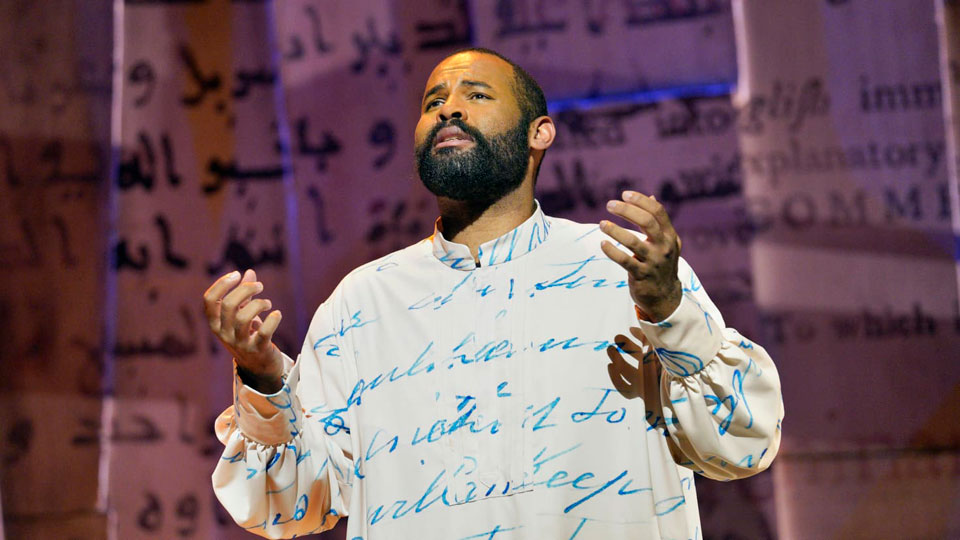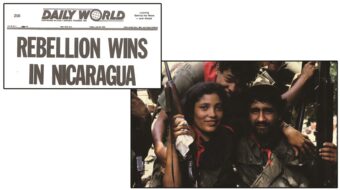
LOS ANGELES—Don’t forget, George and Ira Gershwin’s Porgy and Bess started out on Broadway. Though it still occasionally shows up on theatrical stages, nowadays you’re more likely to see it in an opera house.
Omar has begun its career arc as an opera, but—who knows?—maybe after its initial grand tour of the opera companies that have co-commissioned the work, a regional theater version of this Americana-infused score with a house orchestra could eventually find a home in legit theater. Time will tell.
Anyway, we have a new hit on our hands. Audiences love it, as well they should. I was certainly among the opening night audience here (Oct. 22) who stood up and cheered—for everyone: the creators, the producers, and the amazing mostly African-American cast. It’s a story of brutal enslavement in America, told in an accessible manner both in narrative and song. It’s a paean to survival despite hell, the will to live another day.
Omar is on a fast track. It premiered only this past May at the Spoleto Festival in Charleston, S.C., and was the subject of an ecstatic CBS News story. The Los Angeles Opera production is its West Coast premiere. It is co-produced by Spoleto Festival USA and Carolina Performing Arts at the University of North Carolina, Chapel Hill, and co-commissioned by LA Opera, Spoleto Festival USA, Carolina Performing Arts, Boston Lyric Opera, San Francisco Opera and Lyric Opera of Chicago. It will be making the rounds of these important opera houses and surely beyond in upcoming months and years. Run, run, run! It is not to be missed!

Despite the existence of the autobiography, not much is really known about Omar’s life. The opera takes artistic license to fill in the many blank spots with invented, though historically apt characters to complete the cast. One invented persona is that of the whirling dervish dancer who wordlessly appears throughout the evening at portentous moments in the story.
In 1831, after many discussions with Owen about his own Christian faith and under the impression that Omar had converted to Christianity, the American Colonization Society asked the 61-year-old Omar to write the story of his life. This 16-page autobiography, written in Arabic, and first translated into English in 1848, is the only surviving such document, although some historians today estimate that as many as a third of the slaves impounded from Africa and brought to increase white wealth (and representation in American political bodies) were indeed Muslim. (The conversation about how Christians—and Jews, too, for that matter—could buy and sell other human beings as slaves and justify that activity with their professed faith will, I’m afraid, have to happen outside the halls of this review.)
Omar’s co-composers are Rhiannon Giddens and Michael Abels, both African-American. It’s rare for an opera to have a duo composer credit, but it seems these two were destined to work together on this one. Giddens is largely responsible for the libretto. For many companies that stage Omar, including LA Opera, it will be their first time presenting the work of a Black composer. Giddens is a two-time Grammy winner, a widely known singer and cofounder of the Carolina Chocolate Drops, songwriter, actress, researcher specializing in many genres of American music, who also delves into Celtic culture. YouTube her name and you can entertain yourself all day with clips of her accomplishments, among which are a MacArthur Foundation “genius” grant.
Michael Abels, also well represented on YouTube, is a famous award-winning composer for film and concert hall. He is Jordan Peele’s go-to composer for film scores—Get Out, Nope and Us. Giddens came up with many of the vocal lines and ideas for Omar’s arias and numbers, but as a trained orchestrator Abels filled out the score. The full-evening opera (2 hrs. and 45 mins. with one intermission) is sung in English with English subtitles, though some Arabic words are also included. The score features a fusion and synthesis of musical Americana, both Black and white, and healthy dollops of African and Middle Eastern rhythms and tonalities. However simple a melody might seem, the orchestration consistently added depth that musicologists of the future will have a picnic analyzing. Abels employs the harp to summon a West African instrument, the kora, at critical moments in the drama, not wishing to burden future producers with the need to seek out specialized performers, not even on the banjo, for example.

Omar died in 1864, well into his 90s, never having achieved his freedom, by then a treasured and protected figure. The opera reflects his sustaining, guiding faith. Frequent visions from his adored mother Fatima (Amanda Lynn Bottoms) reinforced his inner conviction that Allah saw a straight path for Omar even if to him it looked bent and winding. This comforting belief stayed with him all through the Middle Passage—a powerful scene in the opera—and the rest of his life.
There’s a particular conceit to the opera that helps the audience understand it not as an apologia for Islam, nor even as an endorsement of any religious faith as an opiate dulling the pain of enslavement. Tenor Jamez McCorkle, who performs the punishing role of Omar, as he did at Spoleto, walks onstage in casual short pants and sporting an Alice in Chains t-shirt. At the very end, he takes off all his robes and reverts to these same clothes. It’s an echo of Leoncavallo’s opera Pagliacci, the clown dressing up in costume for a show, not to be mistaken for the performer engaged to represent this story.
Omar’s writing, which has been preserved in its original incarnation at the Library of Congress, inspires not just the opera but its decor as well—projected onto solid and draped scenic elements and even incorporated into the costume patterns. The fact that so many outfits contain this calligraphy suggests that the Muslim influence, in terms of DNA as well as philosophy, like race itself, may be more widespread in America than most people would care to admit. The first scene, taking place in an idyllic Islamic Senegal before the slavers came, is a parade of bright clothing and spiritual joy. White masters, on the other hand, have costumes also with writing on them—lists of the slaves on their plantations.
Scenic designer Amy Rubin has cleverly incorporated natural features into the mise en scène. She has whole trees made of strands of rope, an allusion to lynching not lost, I hope, on viewers. Johnson, Omar’s first purchaser, for $70, is cleverly “othered” in the opera—meaning placed outside the norm for his time and place—as his heavily Southern-inflected speech is literally “translated” into English for operagoers to understand him. Clever touches with the lighting occur in the first act—one during the slave auction, when the audience lights come up a few notches, as though we were party to the scene—and again at the end of the act when Omar escapes and Johnson’s men shout “Fetch the dogs!” Is Omar hiding somewhere in the orchestra section?

The transition from Johnson’s satanically cruel slave labor regime to Owen’s more benign slave labor regime certainly had to be the main event that kept Omar alive so long. Otherwise he would surely have been worked to death. Toward the end the opera features the enslaved chorus at Owen’s plantation performing a day-off “corn likker” square dance (choreographed to feature many recognizable Black-originated dance styles from as late as the 20th century and beyond), without pounding it into our brains that alcohol was used by the white man, as with Indigenous peoples, to weaken the slaves and deter resistance. Omar participates in a scene with a soulful rendition of the 23rd Psalm (“The Lord is my shepherd”) from the Hebrew Bible, commenting that Jesus was “a mighty prophet indeed, but not mine.” The chorus appears, singing an uplifting arrangement of “Amen,” which could itself, I think, find a home in church services if published in an SATB version. Christians in the audience will appreciate this scene. At the same time, Abels attempts to contrast any thought of sugarcoating with rhythmic work songs.
Christian religion was taught to inculcate an attitude of submission and spiritual, if not physical release. The same can be said about Omar’s attachment to Islam. Yes, his faith sustained him, as faith in eventually sitting “over Jordan” at the right hand of Jesus also inspired many others of the enslaved. But to what extent did religious belief focused on individual deliverance sap the community of their collective resistance? As it’s remarked in the libretto, some of the enslaved are “waiting to go” while others are “desperate to go.” This is an old and highly debated topic.
Does such a picturesque, tuneful scene serve to blur realities? Julie offers, “We got a good life here, you know”—compared to life on Johnson’s farm. Are we really supposed to agree with this assessment, or is it, like, totally ironic? Acknowledge gradations of suffering, nuances of enslavement? I suppose it’s comforting to feel that it wasn’t all bad: Some slaveowners were better than others. I trust operagoers will be smart enough to suss this out for themselves. But as my companion on opening night sniffed, “Too many happy people on that stage.”

A more contemporary reference to involuntary containment turns up in act two when the Detention Order for persons of Japanese descent included in a scenic montage.
Kaneza Schaal is the brilliant director who pulled it all together, only the second Black director in LA Opera’s history. Omar’s story, she says, is now delivered into the hands of opera—“A form built on hundreds of years of cultural exchange, sonic exchange, formal and aesthetic encounters with ‘others.’ A form dependent on many different kinds of artists teaming up. A form built of hybridity. Perhaps one of the only places big enough for a Said’s journey, the contradiction, the violence, the holiness, the omissions, the terror, and the triumph.”
The conductor is Kazem Abdullah, currently based in Nuremberg, Germany, an alumnus of LA Opera’s Domingo-Colburn-Stein Young Artist Program now making his company debut. He made his Metropolitan Opera debut in 2009 conducting Gluck’s Orfeo ed Euridice and returned in 2021 to conduct Fire Shut Up In My Bones.
Omar has several remaining performances, on Nov. 2, 5, 9 and 13 at the LA Opera, 135 N. Grand Ave. in downtown Los Angeles. For tickets, see here. Omar represents a positive move forward in the art form, and though challenging at times for its subject matter, it is a landmark that sets a new high bar.
On opening night—it would be remiss of me not to include this—representatives of IATSE were handing out informative circulars about the ongoing struggle for the wardrobe workers at LA Opera to get management to agree to a contract.












Comments